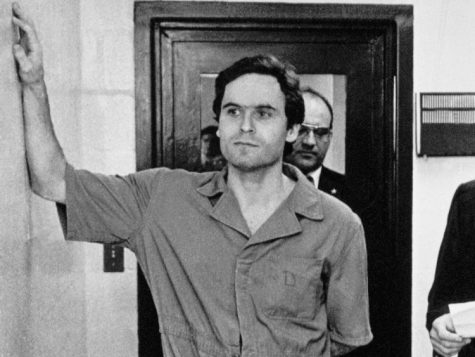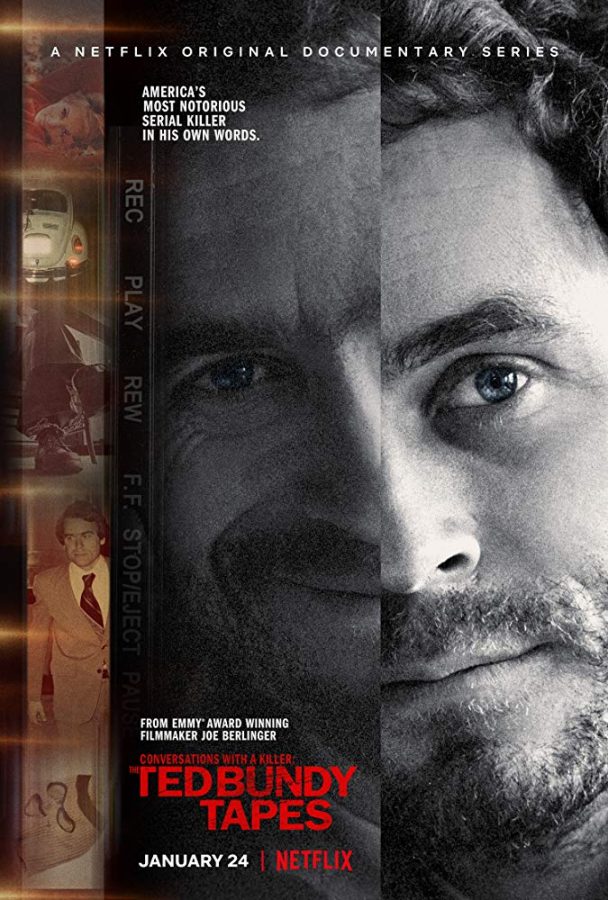Ted Bundy continues to charm after his death
March 6, 2019
Content warning: This show contains very graphic descriptions and images, and may not be suitable for sensitive viewers.
“Conversations with a Killer: The Ted Bundy Tapes” is a four-part documentary series. or docuseries, about Ted Bundy, one of America’s most infamous serial killers. Director Joe Berlinger combines never-before-heard tape recordings of Bundy with vivid imagery and interviews to create a chilling true crime story.
In addition to the tapes themselves, much of the audio comes from interviews with people who were involved in Bundy’s case. Berlinger interviewed reporters and detectives who investigated Bundy’s case, friends and colleagues of Bundy, and even a victim who was able to escape. These interviews provide first hand experiences with Bundy, as well as a variety of ideas about his guilt.
These interviews are supplemented by a variety of images and videos. Throughout the docuseries, shocking photos of Bundy’s crime scenes are shown on-screen in full, uncensored gore. Berlinger incorporated actual T.V. news footage and newspaper articles about Bundy’s crime, as well as images of Bundy, including home videos from his childhood, T.V. interviews from his career, and footage of his testimony in the courtroom. The series also includes photos and videos from the 1960s, 70s, and 80s that are not directly about Bundy, but help to frame the culture of the era for the modern viewer.
Berlinger and his editors expertly align the audio to the visual imagery. The interviews and testimonies of Bundy would be unsettling on their own, but combined with the striking visual representations, they tell the story of a deeply disturbed man, capable of unthinkable horrors. Furthermore, the combination emphasizes how Bundy seemed like a perfectly normal man, which led to incredulity about his guilt.

Indeed, the “average guy” aspect sparked controversy about this docuseries. Viewers criticized Berlinger for romanticizing Bundy. Since its release, some critics have pointed out that the interviewees described Bundy as “normal” and even “charming,” which they perceived as complimenting him.
These critiques ignore the fact that this is exactly what made, and continues to make, Bundy’s murders so terrifying. As Bundy himself states, “People don’t realize that murderers do not come out in the dark with long teeth and saliva dripping off their chin.” The show aims not to romanticize Bundy, but to remind its audience that even the vilest people may appear to be respectable members of society.
Although this retelling of Bundy’s murders is compelling, it is somewhat hard to follow. This is partially because it is broken into four parts, and is further complicated by the use of a non-linear timeline. The docuseries does indicate each jump in time to the audience, but this is not enough to offset the often confusing changes in the narrative. It also spends excessive time on some murders, and practically skips over others. While this issue is likely caused by a lack of evidence or information, it nonetheless leaves gaps in the story.
This docuseries is a sensationalized presentation, without being inappropriate or disrespectful to the victims. Viewers looking for a new take on the story of Ted Bundy may be disappointed by this docuseries. The previously unheard audio from the tapes provides minimal information that will be new to avid true crime followers, as Bundy avoided talking about any of his crimes. However, for those with a more casual interest, or who are new to the genre, this is an informative and deeply disturbing tale that is sure to be a gateway into the world of true crime.


